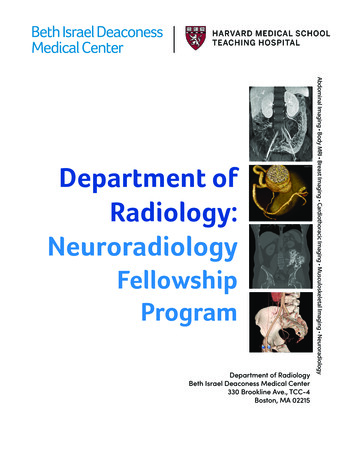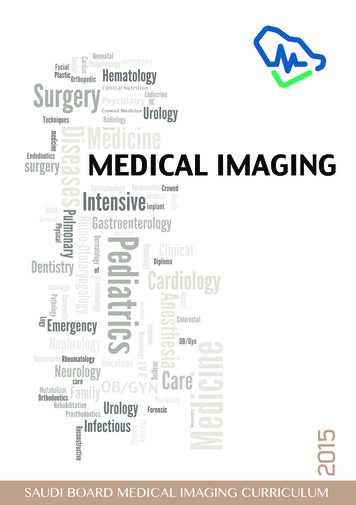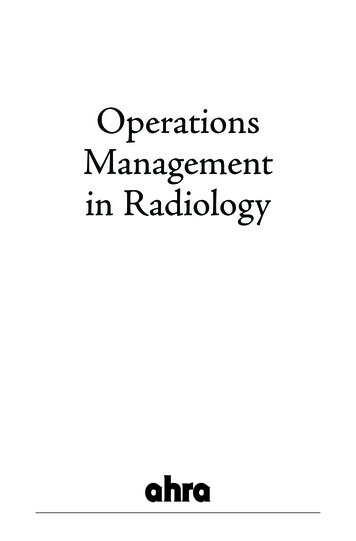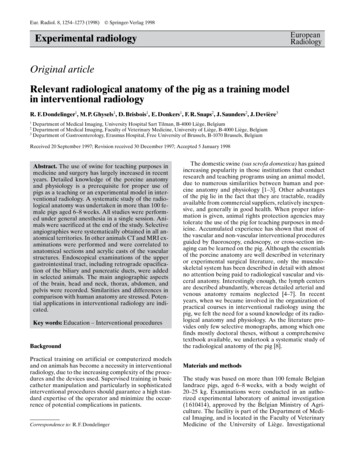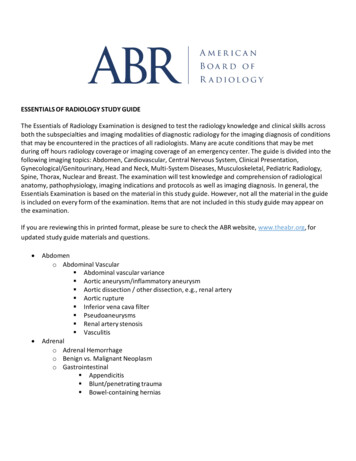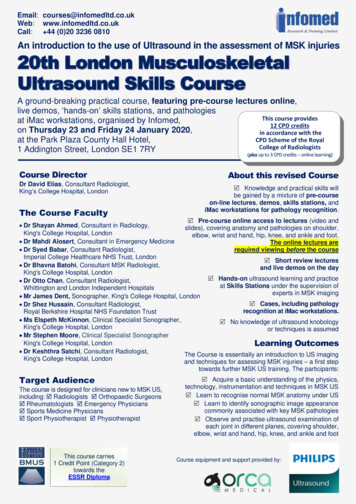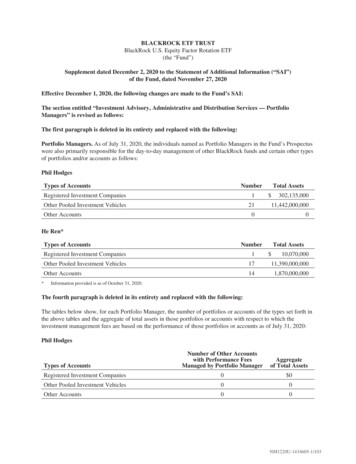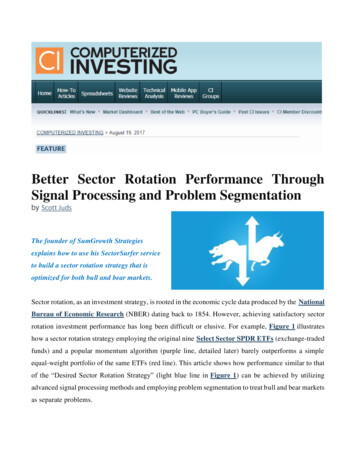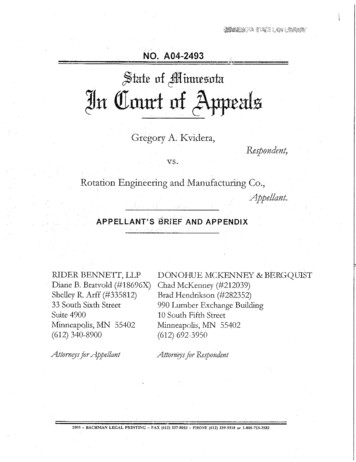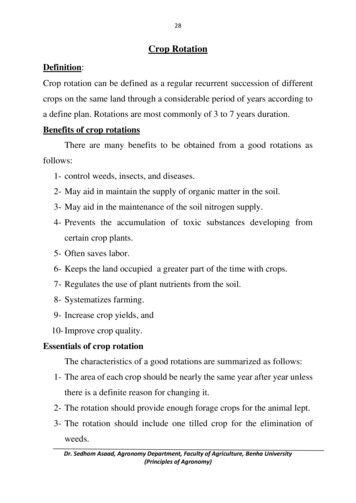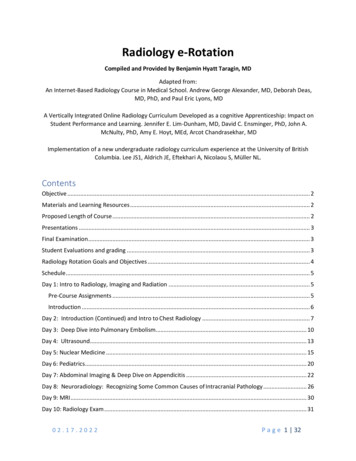
Transcription
Radiology e-RotationCompiled and Provided by Benjamin Hyatt Taragin, MDAdapted from:An Internet-Based Radiology Course in Medical School. Andrew George Alexander, MD, Deborah Deas,MD, PhD, and Paul Eric Lyons, MDA Vertically Integrated Online Radiology Curriculum Developed as a cognitive Apprenticeship: Impact onStudent Performance and Learning. Jennifer E. Lim-Dunham, MD, David C. Ensminger, PhD, John A.McNulty, PhD, Amy E. Hoyt, MEd, Arcot Chandrasekhar, MDImplementation of a new undergraduate radiology curriculum experience at the University of BritishColumbia. Lee JS1, Aldrich JE, Eftekhari A, Nicolaou S, Müller NL.ContentsObjective . 2Materials and Learning Resources . 2Proposed Length of Course . 2Presentations . 3Final Examination . 3Student Evaluations and grading . 3Radiology Rotation Goals and Objectives . 4Schedule . 5Day 1: Intro to Radiology, Imaging and Radiation . 5Pre-Course Assignments . 5Introduction . 6Day 2: Introduction (Continued) and Intro to Chest Radiology . 7Day 3: Deep Dive into Pulmonary Embolism. 10Day 4: Ultrasound. 13Day 5: Nuclear Medicine . 15Day 6: Pediatrics . 20Day 7: Abdominal Imaging & Deep Dive on Appendicitis . 22Day 8: Neuroradiology: Recognizing Some Common Causes of Intracranial Pathology . 26Day 9: MRI . 30Day 10: Radiology Exam . 3102.17.2022P a g e 1 32
ObjectiveThrough independent required reading assignments, online modules, and on-linescenarios, students will learn to incorporate evidence-based strategies for imaging services, whileexperiencing the science, and diversity of modern imaging.Materials and Learning ResourcesNOTE: Some of the links may be blocked by institution firewall if not accessing from a personal device. Required Textbook: Online/eBook edition of Learning Radiology: Recognizing the Basics 4thEdition by William Herring author. Philadelphia, PA: Elsevier -- 4th Edition. -- 2019, 2020Required Textbook: Pediatric Nuclear Medicine and Molecular Imaging S. Ted Treveseditor.New York, NY: Springer New York: Imprint: Springer -- 4th Edition. – 2014Required: A Laptop computer capable of accessing the internet, some of the resources requireAdobe Flash player installed on your laptopDevice (Apple or Android) to download the UBC Radiology app http://www.ubcradiologyapp.ca/Castle Mountain Atlas: http://www.castlemountain.dk/atlas/index.php (Review instructionshere)Geisle School of Medicine Human Anatomy Learning Modules:http://www.dartmouth.edu/ anatomy/HAE/Radiology Intro/rad/rad2/rad2a.htmlACR Appropriateness Criteria: iatenessCriteriaChildren’s Hospital Cleveland 10/pedrad/default.htm (requires creating a freeaccount)Radiopaedia: https://radiopaedia.org/Radiopaedia Playlists: https://radiopaedia.org/playlists/7314?lang usLoyola Medical Student Radiology Radio/curriculum/Structure/image list g.htmRadiology Assistant: .T.E. Radtorials / Weill Cornell Radiology Radtorial Modules radiology.com: /homeUniversity of Wisconsin Neuroradiology Learning es/home/Aquifer Radiology osed Length of Course2- week elective (9 day course with final exam)02.17.2022P a g e 2 32
PresentationsEach student will present an actual case history (with HIPAA information redacted) along withassociated imaging studies. The student will lead the Problem-Based Learning discussion through thedifferential diagnosis to its conclusion, using ACR criteria for rces/ACR-Appropriateness-Criteria, and actual images withinterpretations. This will represent 20% of the final course grade. You will be involved in internet-basedsmall group sessions with classmates and radiology specialists.Final ExaminationThe final exam is a national shelf exam. It includes image-based questions, as well as questions withoutimages regarding anatomy, appropriate ACR imaging management, and other general principles ofdiagnostic imaging. The final exam is based on material covered in modules, assigned links, chaptersfrom Herring, and lectures.Student Evaluations and grading Take final screen shots of completed modules or print certificates as available for your studentrecordsMRI and Radiation Safety Quiz (Passing is Mandatory)A 5-minute student presentation on a self-selected case history presentation during the secondweek (20%)Completion of online quizzes (measuring completion of required readings and modules)(30%)Completion of online modules (40%)Final examination consisting of NBME (or NMBE like) questions based on information andimages covered in online material 30%02.17.2022P a g e 3 32
Radiology Rotation Goals and Objectives1. Knowledge for Practicea. Know critical and high priority imaging findings and diagnoses and understand basicinterpretive techniques in each subspecialty area.b. Know the indications for the most important imaging examinations in each oftheRadiology subspecialty areas.c. Demonstrate knowledge of human anatomy by recognizing key structures on variousimaging modalities in each of the Radiology subspecialty content areas.2. Patient Care (Problem Solving and Clinical Skills)a. Regard the critical importance of useful clinical history in imaging interpretationb. Recognize the consequences of radiation in humans of different genders and agesc. Understand the effects of radiographic contrast on patients with kidney disease3. Practice-Based Learning and Improvementa. Describe the common imaging findings of at least one pathologic entity, presentanimagingb. Present differential diagnosis of these findings and demonstrate understanding of theappropriate imaging evaluation and involved pathophysiology.4. Systems-Based Practicea. Understand the role of the radiologist in the care of patients undergoing imagingevaluationi. and/or image guided procedures for whom such evaluation or procedures arebeing considered.b. Know the relative costs associated with radiologic testingc. Understand the role that false positive and false negative results from mammographyhave on recommendations for screening5. Interpersonal and Communication Skillsa. Effectively advise patients and colleagues on the risks, benefits, limitations andindications of each of the most common imaging examinations.b. Demonstrate understanding of the important role of communication in radiology withspecific emphasis on the radiology report, urgent or unexpected findings,recommendations for follow-up imaging or procedures, and doctor patientcommunication.6. Professionalisma. Demonstrate understanding of the principles of mutual respect, honesty, and discretionin the use of patient clinical and imaging data, during lecture, as a part of the clinicalradiology team, and when interacting with referring clinicians and non-radiologycolleagues and support staff.7. Interprofessional Collaborationa. Demonstrate the ability to engage in an Interprofessional team in a manner thatoptimizes safe, effective patient and population-centered care.8. Personal and Professional Developmenta. Demonstrate trustworthiness that makes colleagues feel secure when one is responsiblefor the care of patients02.17.2022P a g e 4 32
ScheduleDay 1: Intro to Radiology, Imaging and RadiationRemember to screen shot final pages for your records.Pre-Course Assignments1. Complete pre elective ive pre/story html5.html2. Screen shot the final quiz result for your records, passing is not required02.17.2022P a g e 5 32
Introduction3. Read Chapters 1 and 2 in Learning Radiology: Recognizing the Basics by William Herring, MD,FACR.a. Recognizing Anything: An Introduction to Imaging Modalitiesb. Recognizing a Technically Adequate Chest Radiograph4. Complete 5 of the 7 Introduction to Radiology modules (links below) including 2 of them thatcontain a quiz. Capture a screen shot of the quiz ology Intro/rad index.htmlIf not directed to this page, please click Human Anatomy then Introduction to Radiology.5. Day 2 prep online activities:a. Watch the videos on Chest Radiography Primer:https://www.youtube.com/watch?v PDaRNPUNc10&feature youtu.behttps://www.youtube.com/watch?v L6bnD2wOEmghttps://www.youtube.com/watch?v 9J8rcmCVoeshttps://www.youtube.com/watch?v bU0Nm7JFJtUhttps://www.youtube.com/watch?v HfNU8DGXFgkb. Download the free UBC radiology app onto your device (iPad, tablet orsmartphone)http://www.ubcradiologyapp.ca/ and complete “Approach for CXR”i. Open app and click the Get Started button02.17.2022P a g e 6 32
ii. On the menu select “Approaches”iii. Select the Approach to Chest RadiographsDay 2: Introduction (Continued) and Intro to Chest RadiologyRemember to screen shot final pages for your records.1. Read Chapters 3 and 4 in Learning Radiology: Recognizing the Basics by William Herring, MD,FACRa. Recognizing Normal Pulmonary Anatomyb. Recognizing Normal Cardiac Anatomy2. On the UBC app complete the “Which Test”, a short 10 question quiz.a. Open the appb. Click Get Started to open the Menuc. “Which Test” is located under the Clinical Section02.17.2022P a g e 7 32
3. Complete the first 10 clinical cases on the UBC app located under the Clinical Cases section4. Review Chest CT anatomy found at (may take some time to load). Review the instructions onusing the viewer here: /www.castlemountain.dk/atlas/objects.php?atlas AtlasThoraxCT#(or)Loyola PPT atlas of the Chest found rriculum/Structure/image list g.htm02.17.2022P a g e 8 32
(or)The Loyola Chest and Abdomen Atlas PPT located in the Resources folder.5. On any page of the Loyola Site you have opened, click on PCM and complete all the modules onthat subpage. Screen shot final pages for your io/curriculum/Structure/image list g.htm02.17.2022P a g e 9 32
6. On the Loyola site, start the self-evaluation modules listed below. Both self-evaluations shouldbe completed by the end of the first week. Screen capture/print the certificates for theevaluations for your io/curriculum/Structure/image list g.htmDay 3: Deep Dive into Pulmonary EmbolismRemember to screen shot final pages for your records.1. Read Chapters 5 and 6 Learning Radiology: Recognizing the Basics by William Herring, MD, FACRa. Recognizing Airspace versus Interstitial Lung Diseaseb. Recognizing the Causes of Opacified Hemothorax2. Complete short chest quiz under pre-clinical section, anatomy quiz of the UBC app.a. Open the appb. Click Get Startedc. Under the Pre-clinical section, click Anatomy Quiz02.17.2022P a g e 10 32
d. Select the Chest Quiz3. Read and familiarize yourself with the revised PIOPED and modified PIOPED .2022P a g e 11 32
4. Learn about the radiology of Pulmonary embolism bolism5. Review the following lecture on CT of Pulmonary embolism (video):https://www.youtube.com/watch?v Fvkj7qGs7Qo&feature youtu.be6. Review the following papers located in the resources folder or located on PubMed:A safe strategy to rule out pulmonary embolism: The combination of the Wells score and Ddimer test: One prospective study.Ma Y, Wang Y, Liu D, Ning Z, An M, Wu Q, Lin Y., Thromb Res. 2017 Aug;156:160-162. doi:10.1016/j.thromres.2017.06.018. Epub 2017 Jun puted tomography of acute pulmonary embolism: state-of-the-art.02.17.2022P a g e 12 32
Zhang LJ1, Lu GM, Meinel FG, McQuiston AD, Ravenel JG, Schoepf UJ., Eur Radiol. 2015Sep;25(9):2547-57. doi: 10.1007/s00330-015-3679-2. Epub 2015 Mar al radiation dose from CT pulmonary angiography in late pregnancy: a phantom studyS K DOSHI, MPhys, MSc, I S NEGUS, BSc, MSc and J M ODUKO, MSc, PhD, The British Journal ofRadiology, 81 (2008), 302Simplified diagnostic management of suspected pulmonary embolism (the YEARS study): aprospective, multicentre, cohort studyvan der Hulle T, Cheung WY, Kooij S, Beenen LFM, van Bemmel T, van Es J, Faber LM, HazelaarGM, Heringhaus C, Hofstee H, Hovens MMC, Kaasjager KAH, van Klink RCJ, Kruip MJHA, LoeffenRF, Mairuhu ATA, Middeldorp S, Nijkeuter M, van der Pol LM, Schol-Gelok S, Ten Wolde M, KlokFA, Huisman MV; YEARS study group, Lancet. 2017 Jul 15;390(10091):289-297. doi:10.1016/S0140-6736(17)30885-1. Epub 2017 May 23.https://www.ncbi.nlm.nih.gov/pubmed/28549662The Impact of Clinical Decision Rules on Computed Tomography Use and Yield for PulmonaryEmbolism: A Systematic Review and Meta-analysisWang RC, Bent S, Weber E, Neilson J, Smith-Bindman R, Fahimi J.Author information, Ann Emerg Med. 2016 Jun;67(6):693-701.e3. doi:10.1016/j.annemergmed.2015.11.005. Epub 2015 Dec 31.https://www.ncbi.nlm.nih.gov/pubmed/26747217Day 4: UltrasoundRemember to screen shot final pages for your records.1. Read chapters 19 and 20 in Learning Radiology Recognizing the Basics by William Herring, MD,FACRa. Ultrasonography: Understanding the Principles and Its Uses in Abdominal and PelvicImagingb. Vascular, Pediatric and Point-of-Care Ultrasound2. Read Ultrasonography: Understanding the Principles and Its Uses in Abdominal and PelvicImaging, Peter Wang MD3. Review the Radtorial on the Ultrasound Evaluation of the und Evaluation of the Scrotum output/storyhtml5.html02.17.2022P a g e 13 32
4. Review the Radtorial on the Ultrasound of the Female Patient with Pelvic Pain:https://s3.amazonaws.com/CREATERAD/RadTorial Ultrasound Evaluation of the Female Patient with Pelvic Pain - Storyline output/story html5.html5. Complete the genitourinary modules 1, 3 and 5 in I.C.A.R.U.S platform. Screen capture the finalimage for each module for your 17.2022P a g e 14 32
6. Compete gastrointestinal modules 1 and 4 in I.C.A.R.U.S platform. Screen capture the finalimage for each module for your 7. Complete the Ultrasound quiz under pre-clinical section of the UBC appa. Open the appb. Click Get Startedc. Under the Pre-clinical section, click Ultrasound QuizDay 5: Nuclear MedicineRemember to screen shot final pages for your records.02.17.2022P a g e 15 32
Chest case review – Game of Unknowns, Chest Edition. Screen capture the final slide. Who will sit on theUnknown Throne?https://s3.amazonaws.com/CREATERAD/Game of Unknowns Chest Edition Storyline output/story html5.html1.2. In the Learning Radiology Recognizing the Basics by William Herring, MS, FACR, under theOnline-Only Appendixes section (check Table of Contents), read the Nuclear Medicine:Understanding the Principles and Recognizing the Basicsa. Complete the online nuclear medicine module assessments and activities described inthis section.2. Complete the Loyola University modules located under Medicine and dEd/Radio/curriculum/radiologycurric1 f.htm02.17.2022P a g e 16 32
a. After Hida Scan module. review: https://radiologyassistant.nl/abdomen/lk-jgi. ACTIVITY: Draw (either on your computer or pen & paper) a Hida Scan for acase of choledocholithiasis and a case of choledocholithiasis with CBDobstruction. INCLUDE IN YOUR SCREEN CAPTURES FOR THE DAYb. After the Tagged RBC Scan (important to review the cine files [avi or animated gif] tounderstand the images), review the following cases on Gastric Bleed and Diverticularbleed (PDF version located in the Resources folder):i. http://gamma.wustl.edu/gi007te177.htmlii. http://gamma.wustl.edu/gi009te177.html02.17.2022P a g e 17 32
c. After Bone Scan, review the following cases on Metastatic prostate carcinoma and Leftshoulder osteomyelitis (PDF version located in the Resources folder):i. http://gamma.wustl.edu/bs054te143.htmlii. http://gamma.wustl.edu/bs131te142.html02.17.2022P a g e 18 32
02.17.2022P a g e 19 32
3. Review the Radtorial module on oncologic imaging:https://s3.amazonaws.com/CREATERAD/Game of Unknowns Pediatrics Edition Storyline output/story html5.html4. Read chapters 21 and 26 in the book Pediatric Nuclear Medicine and Molecular Imaging S. TedTreves editor. New York, NY: Springer New York : Imprint: Springer -- 4th ed. – 2014.a. Chapter 21: Lymphomas and Lymphoproliferative Disorders by Frederick D. Grant, Pages479-496b. Chapter 26: Combined PET/MRI in Childhood by Thomas Pfluger, Wolfgang Peter Mueller.Pages 597-620c. ASSIGNMENT: Describe in one paragraph a disease you have seen or read about and howPET-CT or PET-MRI help in diagnosis, management or therapy, and what innovation youthink would be useful in treatment of that disease. Creative thinking and science fictionencouraged!Day 6: PediatricsRemember to screen shot final pages for your records.1. Read Recognizing Pediatric Diseases chapter 28, pages 324-338 in Learning Radiology:Recognizing the Basics, by William Herring MD, FACR02.17.2022P a g e 20 32
2. Then please complete a minimum of 7 modules on the Children’s Hospital Cleveland Clinicwebsite: ad/default.htm You will need toregister as a new user on the site using the menu located to the right.02.17.2022P a g e 21 32
3. Complete the Game of Unknowns Pediatric Edition:https://s3.amazonaws.com/CREATERAD/Game of Unknowns Pediatrics Edition Storyline output/story html5.html4. Complete the 5-question online quiz and capture a screen shot of your final score onLearningRadiology.com site. Passing is not required but if you did not score 100%, pleasesubmit a 2-paragraph discussion on the entity you did not recognize including the clinical,radiologic and management of the condition. PDF version is available in the Resources foldernamed Chest Quiz 102/index0102.htm02.17.2022P a g e 22 32
5. Review the Radiopaedia playlist https://radiopaedia.org/playlists/7314?lang usDay 7: Abdominal Imaging & Deep Dive on AppendicitisRemember to screen shot final pages for your records.1. Read Chapters 13-18 in Learning Radiology: Recognizing the Basics, by William Herring MD,FACRa. Recognizing the Normal Abdomen and Pelvis: Conventional Radiographsb. Recognizing the Normal Abdomen and Pelvis on Computed Tomographyc. Recognizing Bowel Obstruction and Ileusd. Recognizing Extraluminal Gas in the Abdomene. Recognizing Abnormal Calcifications and Their Causesf. Recognizing Gastrointestinal, Hepatobiliary, and Urinary Tract Abnormalities2. Watch the video on reading CAT scan, what windowing does and other PACS usage tips.https://www.youtube.com/watch?v rl8hpjlcDUY&feature youtu.be02.17.2022P a g e 23 32
3. Review the anatomy of the abdomen using one of the s.php?atlas AtlasAbdomenCT02.17.2022P a g e 24 32
4. View the C.R.E.A.T.E. Radcast lectures and complete the assignments:a. View: http://www.create-rad.com/abdominalpelvicctb. View: http://www.create-rad.com/abdominalradiographsc. Complete Module 2 and 3 on the I.C.A.R.U.S. platform. Screen capture the final slide ofeach module: http://www.icarus-rad.com/gastrointestinald. Complete Module 5 on the I.C.A.R.U.S. platform. Screen capture final slide of 7.2022P a g e 25 32
5. Review “Annotated teaching case” and find the appendix in 3 planes axial, sagittal and ct.6. On the same site, al-ct-101#h.p lEVuyI9hzi-ia. Complete 2 of the 8 cases from the Acute Gastrointestinal section and 1 each from Acute abdomen"Basics" and Other "must know" diagnosesb. Using screen captures, make a PowerPoint of the four cases you choose. The PowerPoint shouldinclude at least two images from the abdominal CT with arrows pointing to the findings/organs youthink are abnormal. For example, if you choose a case of Gallstone ileus screen capture 2 images fromthe CAT scan and annotate / point to the areas of abnormality.02.17.2022P a g e 26 32
Day 8: Neuroradiology: Recognizing Some Common Causes ofIntracranial PathologyRemember to screen shot final pages for your records.1. Read Chapter 27, pages 300-323 in Learning Radiology: Recognizing the Basics, 27, 300-323.William Herring MD, FACRa. Recognizing Some Common Causes of Intracranial Pathology2. Review the CT Neuroradiology anatomy on the Learningneuroradiology.com ology/how-to-read-a-head-ct?authuser 03. Review the CT Neuroradiology terms on the Learningneuroradiology.com inology?authuser 002.17.2022P a g e 27 32
4. Watch the Clinical Approach to Head CT video on the C.R.E.A.T.E site.http://www.create-rad.com/headct5. Review the special discussion on contrast use on the Learningneuroradiology.com ology/image-acquisition/contrast?authuser 06. Review the Ratorial on Imaging Evaluation for the Stroke l Imaging Evaluation of the Stroke Patien - Storyline output/story html5.html02.17.2022P a g e 28 32
Review the Stroke material on Learningneuroadiology.com ology/pathology/stroke?authuser 07. Complete 3 cases on the University of Wisconsin Neuroradiology Learning Module. You may useresources (provided below) to complete the cases. Screen capture the last image from eachcase. Click on the ED Room Board to es/home/02.17.2022P a g e 29 32
All the resources you need for the cases are available somewhere gy/home?authuser 0 or you can use anyresources you find.Other optional 17.2022P a g e 30 32
Day 9: MRIRemember to screen shot final pages for your records.8. Read Chapter 21 in Learning Radiology: Recognizing the Basics, 27, 300-323. William HerringMD, FACRa. Magnetic Resonance Imaging: Understanding the Principles and Recognizing the Basics2. Watch the videos on MRI Safety:https://www.youtube.com/watch?v vU-PTCmbxQEhttps://www.youtube.com/watch?v MJbo1ZwnOBM02.17.2022P a g e 31 32
3. Review the MRI PDF located in the Resources folder:4. Complete the MRI Safety quiz located in the Resources folder.Day 10: Radiology Exam02.17.2022P a g e 32 32
Required Textbook: Online/eBook edition of Learning Radiology: Recognizing the Basics 4th Edition by William Herring author. Philadelphia, PA: Elsevier -- 4th Edition. -- 2019, 2020 Required Textbook: Pediatric Nu
